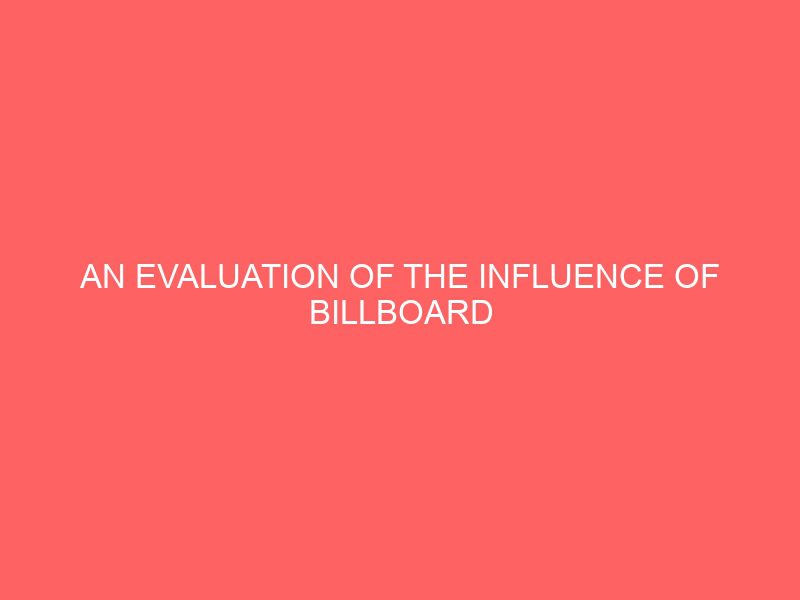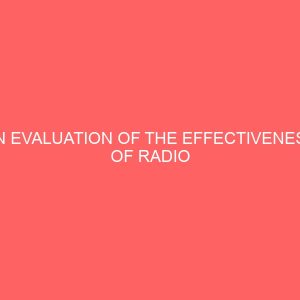Description
CHAPTER ONE
INTRODUCTION
1.1 BACKGROUND OF THE STUDY
Indeed, advertising is one of the tools used for persuasive communication to target audience. Advertising is the communication relayed from companies to persuade an audience to purchase their products. This communication is usually through various forms of paid media. TV and radio commercials print advertising, billboards and more. Every communication is advertising is intended to be persuasive. This becomes clear with the definition of persuasive communication by Osubiyi (1999), which is a conscious attempt by one individual to change the behavior of another individual or groups of individuals through the transmission of some messages. Persuasive communication relates the intention of the communication with resultant behavior of the receiver. Successful persuasive communication produces the desire and behavior while failed ones don’t.
Simply put, advertising is any form of non-personal presentation and promotion of ideas, goods and services usually paid for by identified sponsor. The key points to note are:
i. Advertising is non-personal directed to a range of anonymous people.
ii. Usually paid for, this fact differentiates advertising from publicity which is not usually purchased.
iii. For obvious reason, the sponsor of the advertisement is identified. In fact, in most instances, identifying the sponsor of the advertisement is the prime purpose behind the advert, otherwise why advertise? This is so because by putting their names behind their products or goods, advertisers try hard to fulfill the promise thy claim.
According to the Encyclopedia, American (204) Advertising began around 3200 BC when the Egyptian stenciled insertion the names of kings on temple being built. Later they wrote run way slave enouncement on Papyrus- sign boards were placed outside doors in Greece and Egypt around 1500 B. c perhaps the most important Event in history of advertising was the printing of the Gutenberg Bible about 1450 to 1455. The first time that western man used the principle of moveable type in about 1477 in London, the first printed advertisement in English announced a prayer book sale the first newspaper advertisement appeared on the back paper of in London newspaper in 1625. The easily town crier was also a medium of advertising”.
Advertising has since then been seen to help in economic development in ways of creating jobs sponsoring sports, and the art helps to provide affordable media which encourages competition improves product keep price low and enable people to make informed buying choices Eluwa (2005: 44).
According to Rosson Blatt (1977) advertising is the voice of business such that when it is heard, business is said to have been spoken. All over the world today, advertising seems to have been recognized as an important tool, which facilitates the sale of products and strengthens consumer’s preferences. Manufacturers who continuously work for the sale of their product tends to see advertising as an indispensable tool. In Nigeria for instance, advertising has been employed vigorously on non-price completion to promote the image of competing product brands.
Basically, advertising seek to establish, modify or reinforce attitudes, causing consumers to try a new product, buy more of it or switch brands. Brand advertising seeks to create an image or personality for a product out unique position for it. The rate of advertising in society is a controversial one, largely because opinions associated with it are heavily interwoven with more fundamental vows and beliefs about how a society does and should operate. Aaker and Myers (1989:503): advertising performs some basic functions in the society, first, it serves the marketing function by helping companies that provide product and service and ideas, sells their products in conjunction with personal selling and sales production. Some advertising however maybe aimed at providing public service because it gives us information about goods and services. No wonder the International Advertising Association states: “to be properly informed, the consumer needs advertising”.
Also, advertising help people learn about new products and service and improvements in existing ones through advertising. Agu (1990) asserts that advertising creates awareness, stimulates demand and encourages greater production and ultimately leading to improvement in the standard of living. Hence, advertising provides consumer education as it ensures national and freedom of choice by consumers. The promotion of free and rational consumer choice is a very important aspect of the informative role of advertising. Practical advertising cannot be complete without a clear understanding and application of the principles of consumer’s behavior.
Advertising in Nigeria is traced to be one of the earliest form of mass communication namely town crying. Town criers were used in the dissemination of information about important ceremonies and used in the intertribal wars, disaster, marriages, births death and so on even today town criers are still being used in many villages in Nigeria to communicate vital information the town crier is paid in kind to structure and disseminate his message effectively at the right time and to the right audience. Another common advertising medium in Nigeria in the early days was Hawking. Hawkers advertise their goods by shouting out the names of the waves they were carrying and extolling the qualities of such waves. Despite their advertising validity the earliest form of mass communication soon stepped aside for the modern media mass communication which in the face of mounting commercial growth were found to be more potent in advertising message delivery and wider audience reach. It is worthy to note that the traditional media communication is still in use in some parts of Nigeria as Advertising media.
Modern advertising commenced in Nigeria through the establishment of the first newspaper Iwe irohin in the country. The paper was set up in 1859 and it publisher was Rev Henry Town send of the church missionary society. According to Ogbodoh (2003, 56) when iwe Irohin commenced publication it carries advertisement in form of announcement which includes on births, weddings, death, church activities, vacancies, shipping schedules etc with the setting up of other newspaper namely. Anglo Africa (1863) Lagos weekly Records (1891) Lagos standard (1892) Nigeria pioneer (1914) and so on. The horizon of newspaper advertisement widened considerably. These computed for the revenue that accrued from Government and commercial advertising.
By 1960 advertising had moved into the magazines and the broadcast fold. The significance of the magazines lies in its introduction of color into Nigeria advertising. The radio capitalized on the intimacy of the human voice while television exploited movement which made advertising dramatization possible Nigeria advertising cannot therefore be companies that set the stage for the business environment that powered the advertising dream. Those companies are the royal Niger Company’s which later metamorphosed into United African company (U.A.C) lever Brother cadb. Lny’s A.J scarred, Daily Times, intentioned Bank which later become first bank Nigeria Television Authority (N.T.A) federal Radio corporation of Nigeria (FRCN) .co name just a few these captains of commerce and industry prepared the fertile ground from which Nigeria advertising grew up to productive advert.
Advertising has grown as a tool of academic inquiry, a field of professional practice and an index of modern business. It has come to assume the center of modern business marketing strategy. Billboard advertising has assumed a wider and prominent position of product promotion in recent times in Nigeria. Despite electronic media, billboard advertising got product promotion on the increase and has been dominating the forms of advertising. A result of billboard advertising has emerged as it is recognized by the advertisers as a subsidiary of the Advertising Practitioners Council of Nigeria (APCON). But has been articulated by Adeyemi (1969) the constitutional provisions on freedom of expression can be said to amount only to an orderly freedom of which cannot be used as a license to spread communication that debased public morality.
However, many of these ethical principles have in the course of time, grown to become statutory regulation codified laws. Decree 55 of 1988 among other provisions provides that APCON show regular and control of the practices of advertising in all aspects and ramification. It is in this immense and wide power conferred on it that APCON developed a code of ethics to guide and regulate the practice of advertising in Nigeria which accommodated in no small measure the use of billboards as a way of communicating messages to the masses.
The increase in billboard advertising underscores the effectiveness of billboard on product promotion especially when it has to do with the consumption of such product. Billboards are usually located at point with high vertical and human traffic. Consequently, users of such points are regularly exposed to the advertisement in the board. Secondary, billboards also offers a high degree of vocational flexibility. In other words, the boards can be placed where the advertisers actually intended them to be. In addition, they tend to have lower cost per thousand than most of the other media. They are usually more cost efficient, especially for the advertiser with a small budget.
Billboards offer the advantages of very good color reproduction and at the small time, it is an effective reminder medium offer servicing as a catalyst for buyers who buy in impulse. The greatest problem encountered by advertisers and their agencies with regard to billboard is site monitoring is usually deficient and so when posters get torn or washed out; it takes a while to discover and repost. This is because the site are usually scattered around very far geographical locations.
The posters used on the boards are usually tedious to print and post especially when numbers of sites to be covered are too many. In other words, boards make intense creative demands on the agency because they are usually seen in a fleeting second, they have to be powerfully executed so as to intrude on the passer-by’s consciousness. In this case, they tend to function better as a reminder media and execute the primary and the sole medium for an advertising campaign. Aside its cost efficient, it contributes to environmental aesthetic and enduring feature of landscape of towns in the country.
Wimeck (1982) believes that where advertising is placed, its vehicle affects recall of its message, ratting of its sponsor and returns of its coupon. The billboard or outdoor is basically a communication for people in a hurry, people moving at high speed but whose attention must be caught and held instant. This medium shows the advertiser’s art at its best. The basic design principles fully apply here, layout and illustration have to be very well balanced. Only the basic essentials should be included, everything appearing on the poster must contribute to its effectiveness. Every advertising design must have something to say. This has to be important and should be said straight, plain and simple. The audience does not have time to stop and read between lines for hidden meanings. It has given simple and crisply.
Polaitz (1980) notes that exposure is entirely the responsibility of the medium through the medium’s function goes beyond that into mood it creates in its readers, viewers or listeners, their confidence in the medium and other benefit the medium deliver for its advertising content.
The outdoor medium keeps the message in audience mind and makes the last minutes appeal to audience on their way market. It highlights the more elaborate messages uses repeated impression to make impact; the message has long exposure and ways displayed at strategic points for at least 30 days. Though the outdoor message is open to a large non-selected audience, selectivity and targeting is possible with different posters directed at particular areas where a service or the advertiser product is available.
Again, if one glances down the major lengths in the streets in Abeokuta metropolis, you will notice the presence of trophy lager beer advertising billboard just to help the flag flying and to make sure that the consumers will remain and always patronize their products.
The International Breweries Plc is one of the largest independent manufacturers and distributors of the well-known and widely consumed brands of beers in Nigeria. Their brands are brewing of beer and non-alcoholic malt drinks.
The company was founded by Lawrence Omole in 1971, but began production in 1978 with an installed capacity of 2000, 000 hectoliters. In 1994, the company became a public limited liability company and listed on the Nigeria stock exchange.
Outdoor advertising has become a major advertising medium by advertising firms in Nigeria, especially Abeokuta metropolis using Trophy Lager as a study and it is an indispensable source of revenue for Nigeria state government while advertisers buy space in newspapers and magazines, for outdoor advertisers, they rent cites as Trophy Lager usually points every corner in Nigeria metropolis with its billboard.
In executing this research, the researcher will try to identify why billboard advertising seems to be more popular than other means of advertising in terms of product promotion of billboards in Abeokuta metropolis. Also this study will try to find out the acceptability of billboard advertising in the society. Among other things, this study also helps to establish the contribution of billboards to product promotion, acceptability of billboard advertising in the society. This study also hopes to establish the contribution of billboard to promote business especially when it comes to the consumption of Trophy Lager beer.
1.2 STATEMENT OF RESEARCH PROBLEM
Critics claim that billboard advertising manipulates us into buying things by playing on our emotions and promising greater status social acceptance and sex appeal there is no doubt about the fact that this new and other like it would advertise affect the consumers.
Historically, companies and even professional advert people have questioned or misunderstand the effectiveness of billboard advertising on the consumption of advertised products. Billboard advertising as a major means of selling goods, product and services in Nigeria and all over the world is faced with lots of challenges owing to the development of advertising in Nigeria and challenges associated with rending services customers have so many complaints ranging from awareness to feedback.
Therefore, this study is an attempt to examine critically the rate of influence of billboard advertisement on the consumption of trophy lager beer within the metropolis of Abeokuta. More so, it will tend to determine the rate at which they are influenced by the advertisement and to determine the level of acceptance of the advertisement.
1.3 OBJECTIVE OF THE STUDY
The following are the objectives of the study:
To find out if the International Breweries Plc patronizes billboard advertising within the metropolis of Abeokuta.
To determine the effectiveness of the billboard advertising on the consumption of Trophy Lager products within the metropolis of Abeokuta.
To measure the extent to which billboard advertisement influences the behavior of consumers of trophy lager beer within the Abeokuta metropolis.
To determine if advertisement increases consumer’s preference of trophy laser beer within the Abeokuta metropolis.
To find out whether it carries the same message with other media in the same product.
To find out the contribution of billboards to environmental beauty or otherwise.
1.4 RESEARCH QUESTIONS
For this research work, the following questions were raised by the researcher:
Does International Breweries Plc patronize billboard advertising within the metropolis of Abeokuta?
What is the effectiveness of the billboard advertising on the consumption of Trophy Lager products within the metropolis of Abeokuta?
To what extent does advertisement influences the behavior of consumers of trophy lager beer within the Abeokuta metropolis?
Does the billboard advertisement increases consumer’s preference of trophy laser beer within the Abeokuta metropolis?
To find out whether it carries the same message with other media in the same product?
To find out the contribution of billboards to environmental beauty or otherwise?
1.5 SIGNIFICANCE OF THE STUDY
This study brings to our knowledge the degree of influence of billboard advertisement on the consumption of trophy lager beer within the metropolis of Abeokuta.
The study will also serve as a guide to manufacturers and advertisers in their day to day management of product promotion via Trophy Lager billboard advertising. On the other hand, this study will also serve as good feasibility study for perspective investors in billboard advertising sub-sector.
1.6 SCOPE OF THE STUDY
The study is limited to the Abeokuta metropolis. It is chosen as the area in carrying out the research in this project and all research done within the study is limited to Abeokuta metropolis.
1.7 OPERATIONAL DEFINITIONS OF TERMS
Here, the technical terminologies in the study are operationally defined
a. Impact: This refers to the average number of Nigeria residents that the picture and wording of Trophy Lager billboard have made a striking impression on.
b. Billboard: This refers to a large sign used for advertising of products and services.
c. Promotion: This is the publishing and advertising of product tangible or intangible. This is the placement of Trophy Lager billboard in strategic places in Nigeria metropolis.
d. Product: This is a bundle of utility offered to the consumer by a profit and non-profit organizations.








Reviews
There are no reviews yet.